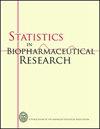编者注:具有事件发生时间结果的临床试验的估计、设计和分析的特别部分
IF 1.5
4区 医学
Q3 MATHEMATICAL & COMPUTATIONAL BIOLOGY
引用次数: 0
摘要
在一些疾病领域,如心血管疾病、肿瘤/癌症或艾滋病毒,临床试验通常收集和分析患者的多次事件(或生存)结果,以评估干预措施的效果。时间到事件结果的方法比二元或连续结果的方法更复杂。设计、监测、分析和报告具有事件发生时间结果的临床试验(事件发生时间临床试验)将需要相当谨慎。在事件发生时间临床试验中,一种常见的做法是首先创建一个复合终点,该终点结合了几个临床相关的事件发生时间结局(例如,心血管疾病中的主要不良事件(MACE),包括死亡、心肌梗死和中风;无进展生存期(PFS),包括进展时间和总生存期),然后对复合终点进行首次事件时间分析。使用复合终点的优点和挑战是众所周知的,并在统计和医学文献中进行了讨论。最近,自ICH- e9 (R1)指南(ICH 2019)中强调的估计框架实施以来,许多统计学家试图重新定义感兴趣的估计,以捕获干预措施的效果和相应的估计量(统计方法)。常见的生存分析方法,如Kaplan-Meier法、log-rank检验、Cox比例风险回归等,有很多优点,在实践中被广泛接受。然而,在某些情况下,它们可能不可行或不能提供可靠的结果。常用的方法是基于本文章由计算机程序翻译,如有差异,请以英文原文为准。
Editor’s Note: Special Section on Estimands, Design and Analysis of Clinical Trials with Time-to-Event Outcomes
In several disease areas, such as cardiovascular disease, oncology/cancer or HIV, clinical trials often collect and analyze multiple time-to-event (or survival) outcomes from patients to assess the effects of interventions. Methods for time-to-event outcomes are more complex than for binary or continuous outcomes. The design, monitoring, analysis and reporting of clinical trials with time-to-event outcomes (time-to-event clinical trials) will require considerable care. A common practice in time-to-event clinical trials is to first create a composite endpoint that combines several clinically relevant time-to-event outcomes (e.g., major adverse cardiovascular events (MACE), consisting of death, myocardial infarction, and stroke in cardiovascular disease; progression free survival (PFS) consisting of time-to-progression and overall survival), and then to perform a time-to-first-event analysis for the composite endpoint. The advantages and challenges of using composite endpoints are well known and have been discussed in the statistical and medical literature. Recently, many statisticians have attempted to redefine the estimand(s) of interest to capture the effects of interventions and the corresponding estimators of the estimand(s) (statistical methods) since the implementation of the estimand framework highlighted in the ICH-E9(R1) guideline (ICH 2019). Common survival analysis methods, such as Kaplan-Meier method, log-rank test, or Cox proportional hazards regression, have many strengths and are well accepted in practice. However, there are situations in which they may not be feasible or provide reliable results. The common methods are based
求助全文
通过发布文献求助,成功后即可免费获取论文全文。
去求助
来源期刊

Statistics in Biopharmaceutical Research
MATHEMATICAL & COMPUTATIONAL BIOLOGY-STATISTICS & PROBABILITY
CiteScore
3.90
自引率
16.70%
发文量
56
期刊介绍:
Statistics in Biopharmaceutical Research ( SBR), publishes articles that focus on the needs of researchers and applied statisticians in biopharmaceutical industries; academic biostatisticians from schools of medicine, veterinary medicine, public health, and pharmacy; statisticians and quantitative analysts working in regulatory agencies (e.g., U.S. Food and Drug Administration and its counterpart in other countries); statisticians with an interest in adopting methodology presented in this journal to their own fields; and nonstatisticians with an interest in applying statistical methods to biopharmaceutical problems.
Statistics in Biopharmaceutical Research accepts papers that discuss appropriate statistical methodology and information regarding the use of statistics in all phases of research, development, and practice in the pharmaceutical, biopharmaceutical, device, and diagnostics industries. Articles should focus on the development of novel statistical methods, novel applications of current methods, or the innovative application of statistical principles that can be used by statistical practitioners in these disciplines. Areas of application may include statistical methods for drug discovery, including papers that address issues of multiplicity, sequential trials, adaptive designs, etc.; preclinical and clinical studies; genomics and proteomics; bioassay; biomarkers and surrogate markers; models and analyses of drug history, including pharmacoeconomics, product life cycle, detection of adverse events in clinical studies, and postmarketing risk assessment; regulatory guidelines, including issues of standardization of terminology (e.g., CDISC), tolerance and specification limits related to pharmaceutical practice, and novel methods of drug approval; and detection of adverse events in clinical and toxicological studies. Tutorial articles also are welcome. Articles should include demonstrable evidence of the usefulness of this methodology (presumably by means of an application).
The Editorial Board of SBR intends to ensure that the journal continually provides important, useful, and timely information. To accomplish this, the board strives to attract outstanding articles by seeing that each submission receives a careful, thorough, and prompt review.
Authors can choose to publish gold open access in this journal.
 求助内容:
求助内容: 应助结果提醒方式:
应助结果提醒方式:


